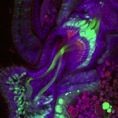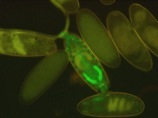The Eberl Lab
269 BB Department of Biology The University of Iowa Iowa City, IA 52242

The Eberl Lab
269 BB Department of Biology The University of Iowa Iowa City, IA 52242
Auditory systems allow organisms to capitalize on information from sounds in the environment. We are interested in the molecular and cellular mechanisms of how organisms detect sound, and how they use the information from sounds to direct their behavior.
We use Drosophila as a model system to examine these processes. The Drosophila male, when courting a female, extends one wing and vibrates it to sing the "love song." The female and the male both hear the love song with their antennae and respond in a sex-specific manner.
Drosophila audition and Mechanotransduction



The movie at the left demonstrates several phases of Drosophila courtship. When the male (the chaser) passes in front of the microphone (left side of frame) you can hear the courtship song.
In Drosophila we can combine genetics with behavioral and electrophysiological methods to dissect hearing mechanisms. We have identified several mutant fly lines that do not respond to sound. Identifying the protein products of these genes and examining their functional roles in hearing will provide new insights into auditory molecular mechanisms, not only in Drosophila, but perhaps in humans as well.
Male flies respond to computer-generated courtship song by forming “chains” as they court other males. The movie at the right illustrates how we detect deaf fly lines by the absence of chaining behavior. Groups of male flies are separated in a plexiglass and mesh testing chamber. When the pulse song is played (starting approx. half way into movie), wild type flies (lanes 1 and 4) respond by forming courtship chains, whereas deaf flies show no response.
Brief overview - for current project summaries please click here

